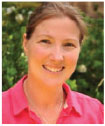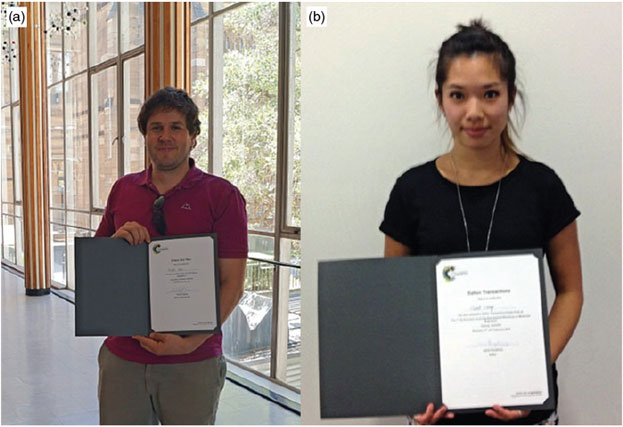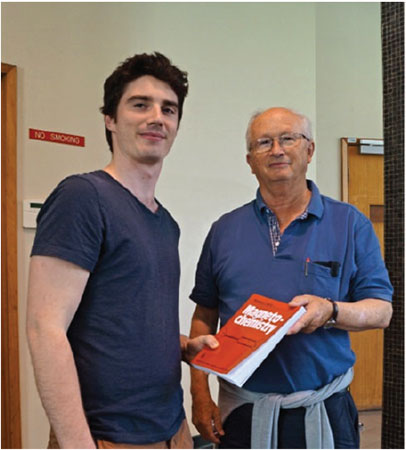An Introduction to Molecular Magnetism: SANZMAG-1 (Southampton-Australia-New Zealand Workshop on Molecular Magnetism)
Suzanne M. NevilleSchool of Chemistry, The University of Sydney, Sydney, NSW 2006, Australia. Email: suzanne.neville@sydney.edu.au

Suzanne M. Neville received her B.Sc. (Hons) in 2000 and Ph.D. in 2005 at the School of Chemistry the University of Sydney on Nanoporous Framework Materials. She then carried out a postdoctoral fellowship within the Molecular Magnetism group at Monash University from 2006 to 2008. In 2009, she was awarded a Marie Curie Fellowship to conduct research within the Institut de Chemie de la Matière Condensée de Bordeaux, France on Photoactive Nanoparticles. In 2011 she was awarded an Australian Research Fellowship within the School of Chemistry, The University of Sydney with research interests in spin crossover, flexible porous materials and nanoparticle development. |
Australian Journal of Chemistry 67(11) 1539-1541 https://doi.org/10.1071/CH14519
Published: 6 November 2014
The inaugural SANZMAG conference was held at the University of Sydney from 17 to 20 February 2014, and was aimed at drawing together local researchers interested in molecular magnetism in an informal workshop-style environment. This meeting was specifically aimed at researchers of honours to postdoctorate level, with leading magnetochemists from the region and further abroad invited to share their knowledge on the basics of molecular magnetism. There are few such conferences available for non-experts in the field to attend, and with Australia and New Zealand having a historically strong reputation of excellence in the broader field of molecular magnetism this was a unique opportunity for all attendees – even those well experienced in the field – to benefit from a refresher on the basics. This unique congress, instigated by Dr Tony D. Keene and Dr Jonathan Kitchen of the University of Southampton (owing to their strong associations within the region) showed that Australia and New Zealand are continuing to expand their interests in molecular magnetism and play a key role in advancing the field. It was fantastic to see 25 undergraduate and graduate students and postdoctoral fellows in attendance to carry on the tradition of molecular magnetism within Australia and New Zealand (Fig. 1).
The first day of the 3 day workshop comprised general introductory lectures focussing on no pre-assumed knowledge – this is often hard to come by in this field which spans both Chemistry and Physics, and rapidly becomes very complicated. Dr Tony Keene, Dr Colette Boskovic, Professor Keith Murray and Dr Richard Mole presented an introduction to the various facets of molecular magnetism; myself and Professor Sally Brooker presented on spin crossover, and Dr Alessandro Soncini presented on single molecular magnetism. With an overwhelming amount of fundamental information conveyed during the day, the poster session with refreshing drinks was a welcome relief. Michele Vonci and Chanel Leong, both Ph.D. students, were awarded Dalton Transactions prizes for the best student poster presentations (Fig. 2). The second day comprised a range of talks discussing specific techniques employed in molecular magnetism such as: EPR spectroscopy by Dr Tom Faust, a postdoc at The University of Sydney; Mössbauer spectroscopy, presented by Dr Guy Jameson from The University of Otago, and structural magnetism by Dr Jason Price representing the Australian Synchrotron. This session was extremely helpful as the importance of understanding these specialised techniques and carrying out such experiments with care is often overlooked in the literature. Four students were chosen to give talks in a dedicated session, and as is often the case with student presentations the quality was excellent. Michael Murphy of The University of Sydney was award the inaugural Keith Murray prize for the best student presentation for his work on spin crossover framework materials (Fig. 3). The workshop ended with case studies from specialised areas, such as anion sensing spin crossover presented by Associate Professor Matthew Shores from Colorado State University, USA.

|

|
This special issue is dedicated to featuring the excellent research that is ongoing in the field. There are two Review articles, one dedicated to polyoxometalate-supported lanthanoid single-molecule magnets and the other focussed on two-dimensional coordination polymers with spin crossover functionality.[1,2] The issue also contains several Focus and Research articles detailing the magnetic properties of novel molecular complexes, clusters, coordination polymers and solid state materials.[3–12]
We would like to thank all of the organisers and participants in this inaugural SANZMAG conference which allowed for its success and we look forward to the next instalment. We also sincerely thank all of the authors who have made such an effort to contribute to this issue. Finally, thank you to the Journal for making this issue possible.
References
[1] M. Vonci, C. Boskovic, Aust. J. Chem. 2014, 67, 1542.| Crossref | GoogleScholarGoogle Scholar |
[2] N. F. Sciortino, S. M. Neville, Aust. J. Chem. 2014, 67, 1553.
| Crossref | GoogleScholarGoogle Scholar |
[3] M. J. Murphy, T. D. Keene, J. R. Price, D. M. D’Alessandro, C. J. Kepert, Aust. J. Chem. 2014, 67, 1607.
| Crossref | GoogleScholarGoogle Scholar |
[4] F. Ragon, K. Yaksi, N. F. Sciortino, G. Chastanet, J.-F. Létard, D. M. D’Alessandro, C. J. Kepert, S. M. Neville, Aust. J. Chem. 2014, 67, 1563.
| Crossref | GoogleScholarGoogle Scholar |
[5] R. O. Fuller, K. L. Livesey, R. C. Woodward, A. J. McKinley, B. W. Skelton, G. Koutsantonis, Aust. J. Chem. 2014, 67, 1588.
| Crossref | GoogleScholarGoogle Scholar |
[6] D. Sertphon, D. J. Harding, P. Harding, K. S. Murray, B. Moubaraki, H. Adams, Aust. J. Chem. 2014, 67, 1574.
| Crossref | GoogleScholarGoogle Scholar |
[7] F. Li, N. F. Sciortino, J. K. Clegg, S. M. Neville, C. J. Kepert, Aust. J. Chem. 2014, 67, 1625.
| Crossref | GoogleScholarGoogle Scholar |
[8] J. E. Auckett, W. Miiller, M. Avdeev, J. A. Kimpton, C. D. Ling, Aust. J. Chem. 2014, 67, 1612.
| Crossref | GoogleScholarGoogle Scholar |
[9] I. A. Gass, M. Asadi, D. W. Lupton, B. Moubaraki, A. M. Bond, S.-X. Guo, K. S. Murray, Aust. J. Chem. 2014, 67, 1618.
| Crossref | GoogleScholarGoogle Scholar |
[10] S. K. Langley, B. Moubaraki, K. S. Murray, Aust. J. Chem. 2014, 67, 1601.
| Crossref | GoogleScholarGoogle Scholar |
[11] S. K. Langley, D. P. Wielechowski, B. Moubaraki, B. F. Abrahams, K. S. Murray, Aust. J. Chem. 2014, 67, 1581.
| Crossref | GoogleScholarGoogle Scholar |
[12] K. A. Schulte, S. R. Fiedler, M. P. Shores, Aust. J. Chem. 2014, 67, 1595.
| Crossref | GoogleScholarGoogle Scholar |



